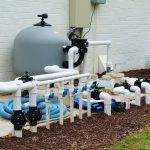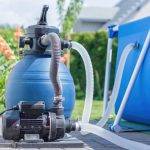One of the most important pieces of equipment for your pool may be the filter gauge. A properly working filter gauge can tell you a lot about the health and well-being of your plumbing system. Besides knowing when to clean your filter, your filter gauge can help you diagnose common pool problems.
Make sure you have a properly working filter gauge
When the pool pump shuts off, the pressure gauge should read zero. Seems obvious but sometimes the gauge can start to stick when they get older. If you are in doubt about the gauge, tap it and see if it moves to a value. Once you know you have a working filter gauge, record the normal clean filter operation pressure as a baseline. This will be useful to know when you are having trouble with the equipment.
When to clean a filter
Manufactures will often tell pool owners to clean their filter when the pressure rises by 8-10 PSI. This may have been ok when pumps were much larger and plumbing was much smaller resulting in much higher clean filter pressures but with the move towards making swimming pools more energy efficient, larger plumbing combined with smaller pumps has resulted in much lower clean filter operating pressures. Under these conditions, allowing the filter pressure to rise by 8-10 PSI can drastically reduce the efficiency of the pump. So to minimize energy efficiency losses, we recommend that you clean your filter before the pressure rises by 25%. For example:
- 10 PSI Clean Filter pressure -> Clean filter when pressure rises to 12-13 PSI
- 15 PSI Clean Filter pressure -> Clean filter when pressure rises to 18-19 PSI
- 20 PSI Clean Filter pressure -> Clean filter when pressure rises to 25 PSI
Pump Run Time
Conventional wisdom is that most pools need 1-2 turnovers per day. However, studies have shown that most pools need far less run time than that and can usually get away with 3-4 hours of run time per day. However, for two speed or variable speed pumps on low speed, the skimming action tends to decrease so the run time may need to be increased to compensate. The bottom line is to run your pump long enough to keep chlorine at recommended levels and to keep the pool clean enough for your own personal preference.
Other Maintenance
Besides cleaning the filter, there are other things you can do during your weekly maintenance to help find small problems before they become big expensive problems:
- Check around the pump for leaks. A common problem with pumps is that they will start to leak around the pump shaft seal after a number of years of operation. This can cause the motor bearings to rust and eventually lead to a motor failure. So it is very important to catch a leak early before it can cause major damage.
- Keep leaves and debris away from the pump motor vents. The vents are very important in keeping the motor cool. Clogged vents can lead to a motor overheating and causing severe damage to the motor windings.
- Keep an eye on the filter pressure. A sudden increase or decrease in filter pressure can indicate a problem with the plumbing (see equipment diagnostics section).
- After cleaning out the pump basket and restarting the pump, makes sure the pump full primes and there is not a lot of air left in the pump basket. That could indicate an air leak.
- At least once a year, check your gas heater’s venturi screen for spider webs that can clog the intakes. The procedure should be in your heater’s manual.





